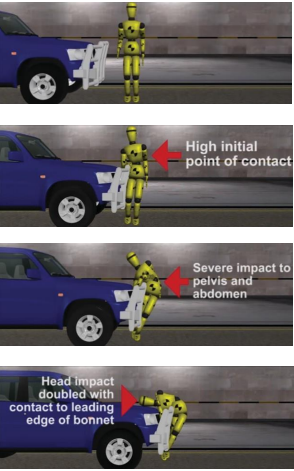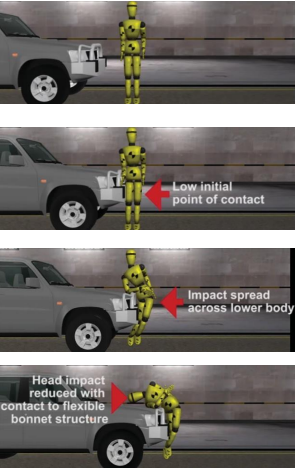On this page
In this webpage, the term Vehicle Frontal Protection System (VFPS) includes bull bars, roo bars, and nudge bars.
The purpose of this information is to assist in understanding the companion page Design and construction.
Background
For many years, a VFPS has been accepted as an accessory for most vehicle types, often fitted to help protect a vehicle in the event of a crash with an animal, such as a kangaroo, by reducing the potential for damage to the cooling system and leaving the vehicle stranded after an impact.
However, when a poorly designed VFPS is fitted to a vehicle, it can be dangerous to vulnerable road users such as pedestrians and cyclists in the event of a collision.
In addition, the continued development of vehicle technology and ongoing improvements in vehicle safety systems have led to a situation whereby the fitting of a non-compliant VFPS may actually interfere with the sophisticated safety systems of the modern vehicles.
A great deal of research has been conducted into the possible effects of a VFPS in a collision and ways of optimising their design. This document has been produced following detailed technical investigations. It supports and builds upon the information contained within Australian Standard AS 4876.1-2002 Motor vehicle frontal protection systems Part 1: Road user protection, which primarily addresses the issue of minimising the risk of injury to pedestrians as a result of colliding with a vehicle fitted with a VFPS.
Safety
Pedestrian safety
Accident statistics, confirmed by scientific studies, have shown that a poorly designed VFPS greatly increases the risk of injury to a pedestrian hit by a car, even at relatively low speeds.
Generally, the severity of the injury is minimised when the pedestrian rolls onto the bonnet of the car. The chances of this happening are better if the point of initial contact between the car and the pedestrian is as low as possible. One of the risks posed by a poorly designed VFPS is that it will raise the point of initial contact and thereby increase the severity of a pedestrian injury.
For vehicles fitted with a VFPS, laboratory testing has confirmed the importance of VFPS design to the outcomes of a pedestrian collision. The images below, taken from a computer simulation conducted by the Centre for Automotive Safety Research (CASR) at the University of Adelaide, demonstrate that compliant VFPS results in lower pedestrian head impact speeds with the vehicle, reducing the severity of the impact and resulting in a reduction to the risk of a serious head injury by well over 50%.
Because the non-compliant VFPS presents a higher point of initial contact, the pedestrian is pushed forward and bent around the top of the VFPS, rather than being swept onto the bonnet of the car, resulting in a much higher risk of spinal, pelvic, and head injuries to the pedestrian, even at relatively low collision speeds.

Noncompliant bull bar

Compliant bull bar
Vehicle occupant safety
Over the last few years, there have been significant advances in the onboard safety systems fitted to new vehicles. The continued development of vehicle technology and ongoing improvements in vehicle safety systems have led to a situation whereby the fitting of a VFPS may actually interfere with the sophisticated safety systems designed for modern vehicles.
Causes of concern
The main causes of concern are outlined as follows.
Incompatibility with vehicle airbags
Nullification of crumple zones
Modern vehicles have crumple zones that protect the occupants by cushioning the impact of a front-end collision. A poorly designed VFPS has the potential to make the front end of the vehicle significantly more rigid, thereby reducing the effectiveness of the crumple zones. This causes a more severe impact on the occupants of all vehicles involved.
Incompatibility with other vehicles
At an international level, significant research is being undertaken towards improving the “crash compatibility” between vehicles involved in vehicle-to-vehicle collisions. The aim of this research is to design vehicles in such a manner that maximises each vehicle’s ability to absorb crash energy. A poorly designed VFPS can negate these design features, thus increasing the risk of more significant injuries to the occupants of other vehicles involved in the collision, than would have been the case had the colliding vehicle not been fitted with a VFPS.
Safety rating of a vehicle fitted with a VFPS
It is recommended that consumers seek written assurance from the supplier, signed by a responsible person, that the VFPS is compliant with AS 4876.1-2002 Motor vehicle frontal protection systems Part 1: Road user protection, and that the vehicle, when fitted with the VFPS, continues to comply with all applicable Australian Design Rules, including:
- ADR 13/00 Installation of Lighting & Light-signalling Devices on other than L-Group Vehicles
- ADR 69/00 Full Frontal Impact Occupant Protection
- ADR 73/00 Offset Frontal Impact Occupant Protection (where applicable).
The VFPS manufacturer must be able to provide evidence for these claims.
Acknowledgments
The Department for Infrastructure and Transport would like to thank the Western Australia Department of Transport, the Australian Automotive Aftermarket Association, and the Motor Trade Association Western Australia for their assistance in the development of information.
Vehicle Standards reference:MR1677.

